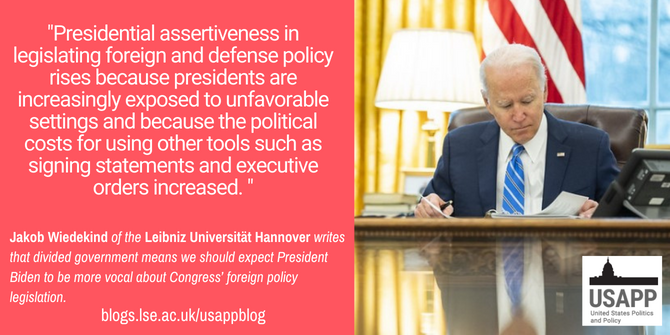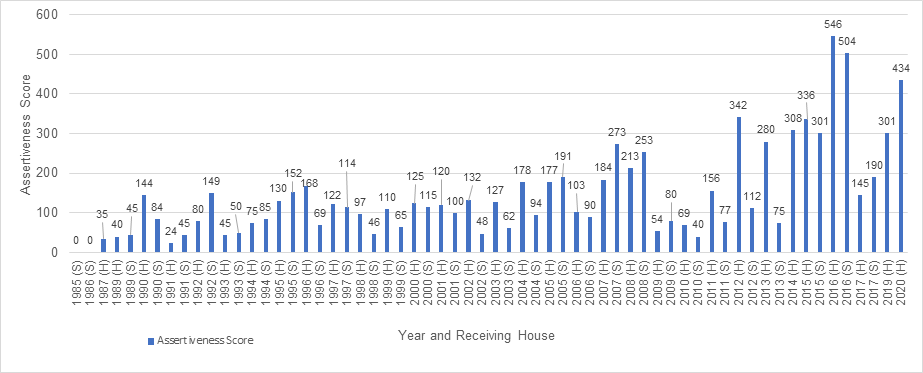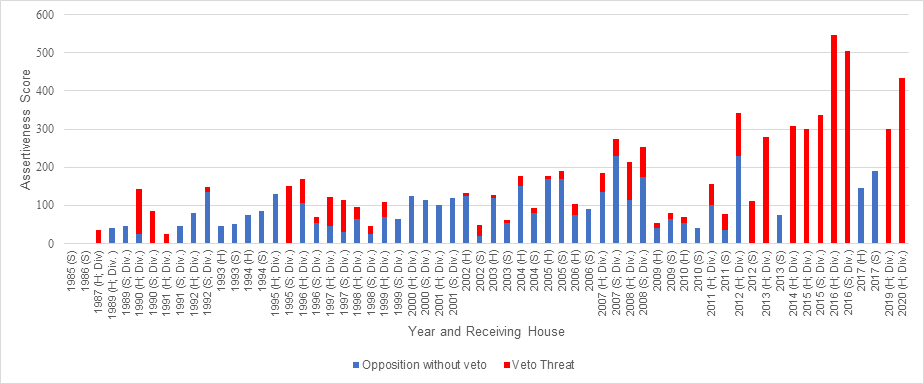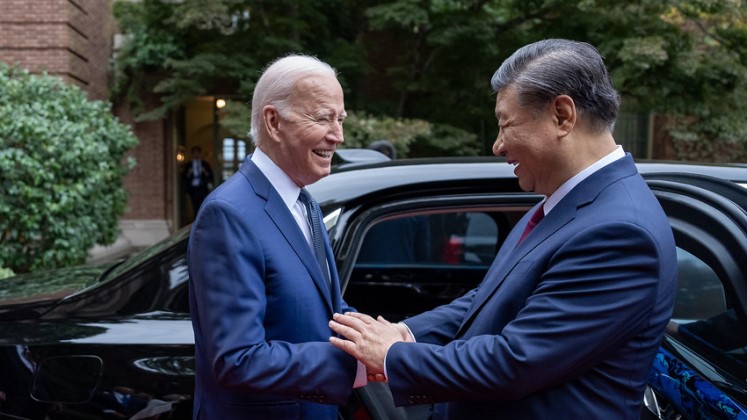 While presidents have significant latitude in foreign policy matters, Congress still has an important voice, especially in authorizing defense spending through the annual National Defense Authorization Act (NDAA). Jakob Wiedekind examines presidential opposition to NDAAs since 1985, finding that presidents are more likely to act assertively when government is divided and towards the end of their term.
While presidents have significant latitude in foreign policy matters, Congress still has an important voice, especially in authorizing defense spending through the annual National Defense Authorization Act (NDAA). Jakob Wiedekind examines presidential opposition to NDAAs since 1985, finding that presidents are more likely to act assertively when government is divided and towards the end of their term.
As the dust of the midterm elections settles, American politics has moved to a setting of divided government where more interbranch friction is to be expected. The specter of unchecked presidential discretion in foreign and defense policy looms large in the way that scholars and commentators think about the separation of powers in American government. Interbranch competition in lawmaking often centers on extensions of presidential power that are at the forefront of the public and academic discourse on legislative bargaining – especially when government is divided, that is, when one party holds the White House while another holds either the US House, Senate, or both. Given that presidents usually exercise their power in foreign policy without Congress by means of unilateral executive action, preemptive interventions – via statements of opposition – in lawmaking often remain overlooked. Yet, presidents are far more active in making known their opposition to pending legislation on foreign policy than conventional wisdom suggests.
Measuring presidential assertiveness in foreign policy
In new research, I calculate a new assertiveness-score to measure the extent of presidential preemptive opposition in Statements of Administration Policy (SAP) released for draft versions of the annual National Defense Authorization Acts (NDAAs). An SAP gives an administration’s formal views (via the Office of Management and Budget) on legislation that is working its way through Congress. I categorize the degree of presidential opposition per addressed section in SAPs released for draft NDAAs pending consideration on the floor. The assertiveness-scores are the sum of all applied codes that identified presidential challenges that range from opposition to high levels of veto threat certainty.
Presidential assertiveness in preemptive messages to Congress increased substantially over time and divided government predicts pronounced executive opposition particularly well. Also, presidents are most assertive when their respective term comes to an end. This suggests that President Biden’s assertions of executive privilege are likely to rise significantly in preemptive messages to Congress as lawmakers draft annual authorization legislation for foreign and defense policy with a Republican majority in the House. More broadly, it appears that authorization legislation gradually becomes a more important venue for struggles between branches over the direction of American foreign policy.

“P20211227AS-0115” by The White House is United States Government Work
Figure 1 shows the yearly presidential assertiveness-scores since 1985. Usually, there are two SAPs per year for each draft NDAA, one for the House, one for the Senate. Figures 1 and 2 connect the assertiveness scores accordingly to the House (H) or the Senate (S). Figure 2 outlines the assertiveness-scores’ composition in more detail by distinguishing between the share of veto threats (red) from the share of veto-free opposition (blue). Figure 2 also indicates settings of divided government depending on whether the receiving house of Congress is controlled by the president’s party.
Figures 1 – Assertiveness-Score per NDAA bill, 1985-2020

Figure 2 – Share of opposition vs share of veto threats, 1985-2020

Figures 1 and 2 show that there has been a gradual change towards more assertive presidential interventions. Another key message is that there appears to be a significant increase of assertiveness over time, with President Obama challenging the legislative content of NDAAs most extensively of all presidents I examined. On average, presidents are also more assertive after the 9/11 terrorist attacks. Beyond these broader trends, the notable variance in the values within administrations stands out and points to the influence of contextual determinants like the composition of government. Obama exhibits the most notable variation during his tenure and the most assertive SAPs overall, while George W. Bush’s second term outpaces his first to the extent to which pending NDAAs are challenged in his SAPs. Clinton on the other hand seems to be rather consistent in his opposition.
Trump stands out in that he broke with the pattern of previous administrations by releasing no SAP for the NDAA drafted in 2018 and by not addressing the companion bills in the Senate in 2019 and in 2020. This fits well with his rather unconventional and often norm-breaking style of heading the executive branch. Interestingly, presidents seem to be particularly assertive when their respective term ends. Having served two terms, George W. Bush and Barack Obama leave office with spiking assertiveness in their respective last years, which is compounded by the divided government at the time.
Why presidents seek other avenues for their foreign policy goals – including veto threats
Presidential assertiveness in legislating foreign and defense policy rises because presidents are increasingly exposed to unfavorable settings and because the political costs for using other tools such as signing statements and executive orders increased. This ties in well with Congress ramping up oversight on executive unilateralism in foreign policy leading presidents to explore other avenues to advocate for their preferences – particularly so when the government is divided. Lawmaking and authorization legislation can impose undesired restrictions on incumbents and often does so by means of limitation riders and spending restrictions. Furthermore, legislation can add reporting requirements to programs covered in the NDAA or restrict presidents in using funds for certain purposes like closing the Guantanamo Bay Detention Camp. Interestingly, presidents increasingly frame their veto rhetoric with constitutional concerns in the sense that certain provisions would violate their interpretations of executive privilege.
Veto threats used to be an action of last resort because interbranch negotiations on the NDAA were less hostile. Now, preemptive and section-specific veto threats are commonplace. Hence, contemporary presidents are not unchecked. Instead, they have to assert their grip on foreign policy against undesired legislative provisions more assertively than ever. Extensive and assertive presidential challenges are characteristic of contemporary interbranch relations – at least with regards to NDAAs. This also becomes evident in that signing statements often mirror presidential challenges in SAPs. Hence, it seems that the latter are part of a larger strategy for interbranch bargaining. This calls for renewed attention to authorization legislation as an important arena where interbranch relations in the struggle to direct foreign policy play out.
- This article is based on the paper, ’Preemptive Action: Measuring Presidential Assertiveness in Foreign Policy Lawmaking’ in American Politics Research.
- Please read our comments policy before commenting.
- Note: This article gives the views of the author, and not the position of USAPP– American Politics and Policy, nor of the London School of Economics.
- Shortened URL for this post: https://bit.ly/41YZM0u






